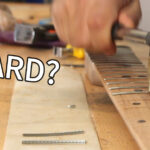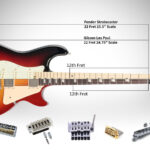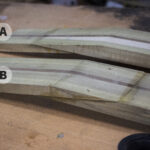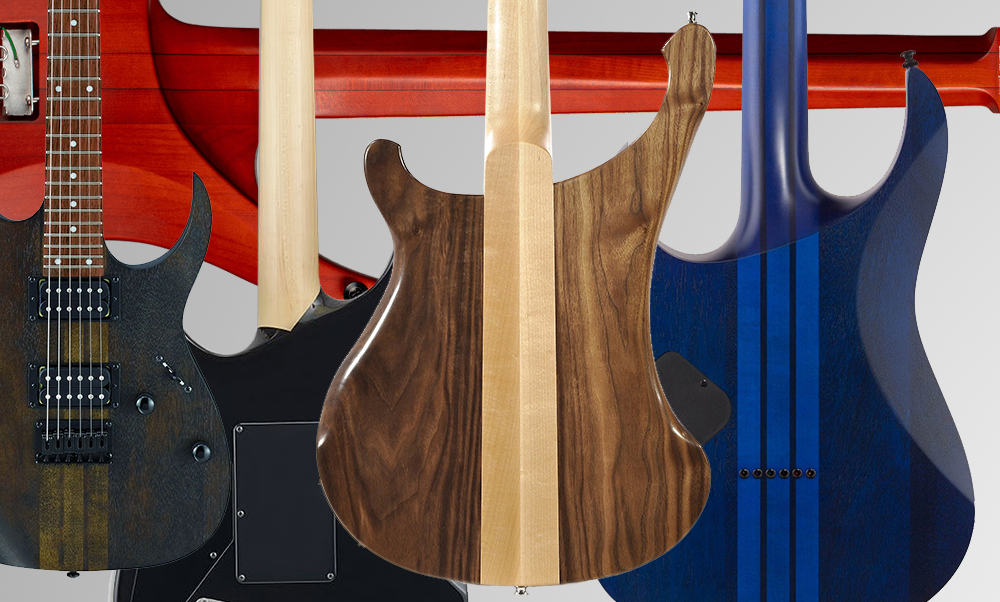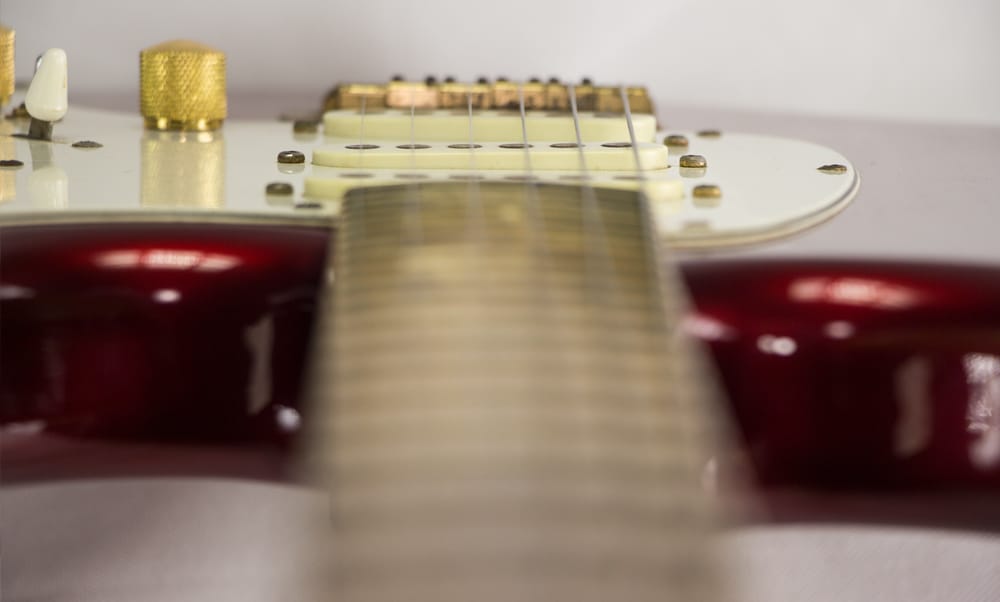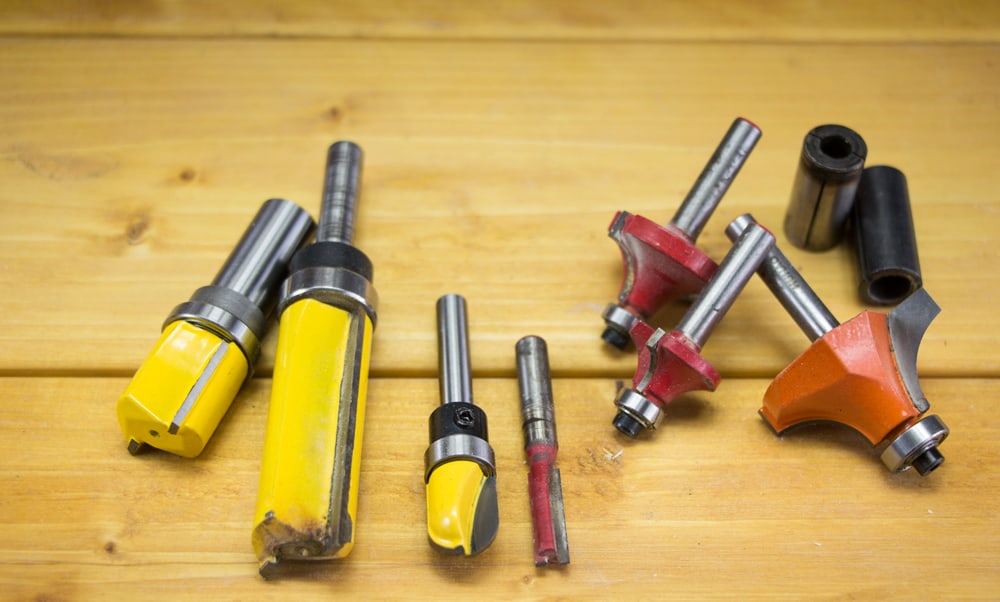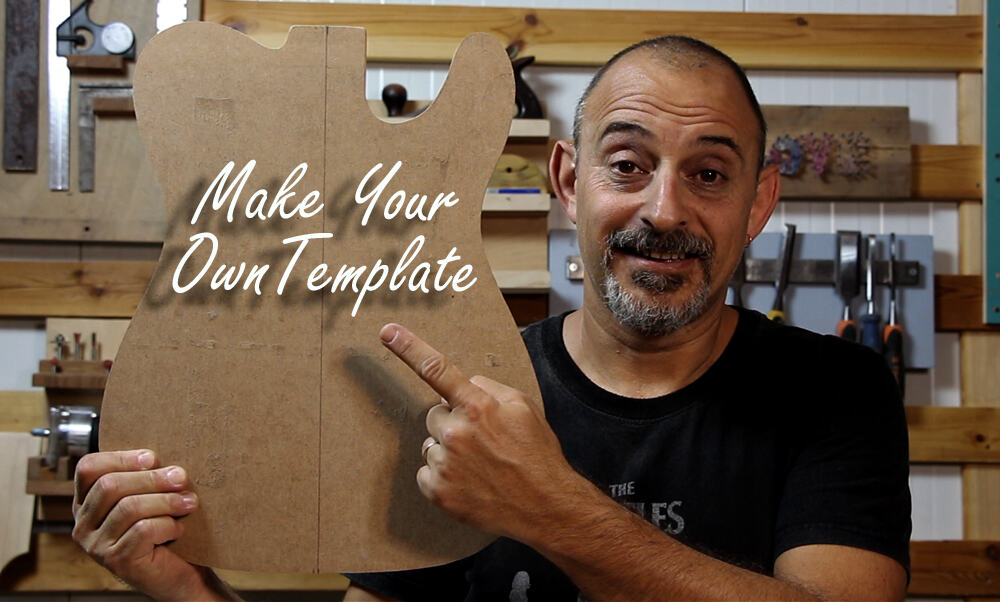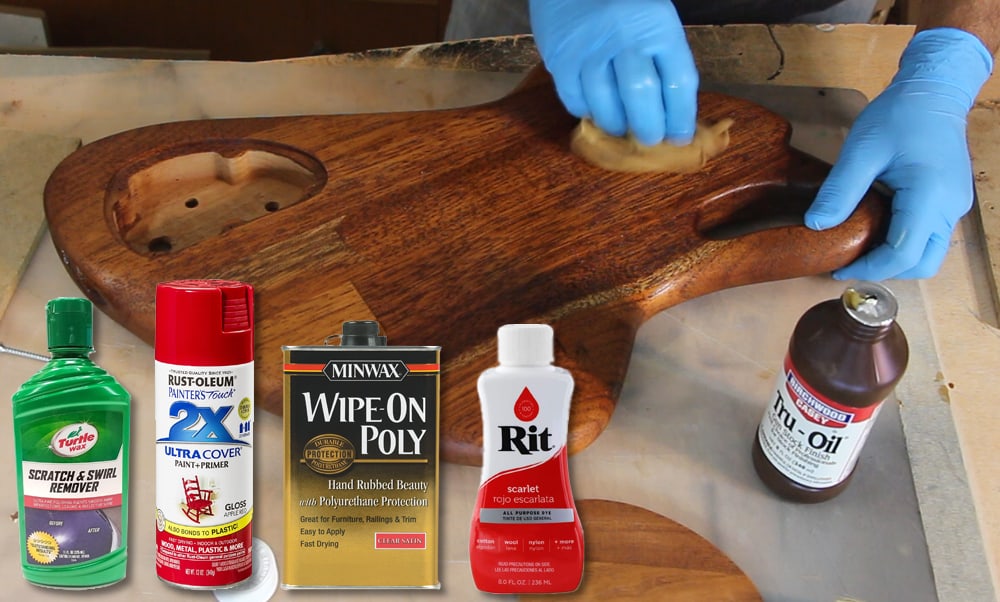When you come to build your own guitar, many considerations of production guitars are not really relevant. When making a custom hand-built guitar and when treating the whole project as a hobby, a few more hours of work are not really considered a problem, maybe it’s a benefit. You have probably seen, heard or maybe played a ‘Neck Through’ guitar and thought to yourself: Should I use this feature on my build? what will the benefits be for me? Is it harder to build?
A ‘Neck Through’ guitar is built around the idea is that the neck and the center of the guitar’s body are made from the same piece of lumber or laminate so there is no ‘connection’ between the two. Neck Through or ‘Neck Thru’ guitars are said to be stiffer and more warp resistant than other types of necks and have better sustain. They will also allow for designs which allow easier access to the very high note frets. We’ll take a look at all these claims and try and understand the pros and cons of having a through neck in your guitar. Are these claims true or just subjective impressions? Is it harder to construct or would actually make life easier for the aspiring guitar builder?
Before we go into the ins and outs of the neck through constructed guitar, we will want to understand a bit more about necks in general and the elusive sustain many are chasing after. Most production guitars are made with more conventional neck and still offer great sound and playability, so what is the difference and what makes that difference.
Disclaimer: As much as I am trying to stick to facts and scientific evidence, it is very hard to pinpoint sustain or any other qualities given to sound to one or other particular factor. Different guitars will sound different for a multitude of reasons, including the materials used, the type of wood, the thickness of the strings, the scale length and the pickups. It is almost impossible to isolate just one factor and objectively define it. On top of that the differences may be very real and objective but may have such a slight effect, most people will not even notice.

How is a ‘Neck Through’ guitar built?
The two most common types of neck are the bolt on, invented and most common in Fender style guitars, and the ‘Set Neck’ which are represented in most Gibson and PRS guitars.
Bolt-on Necks became common with the popularity of Fender guitar in the late 50’s. They offer great manufacturing and repair advantages and can easily be attached and removed. It is also efficient in the amount of lumbar needed and gives great strength and stability if proper quarter sawn wood such as maple is used. Their tone is often described as ‘chimey’ and is considered very clean and crisp (maybe it’s the maple?)
Set- Necks differ from the bolt on ones in that they will usually have a larger and thicker heel and sometimes a dove-tail connection. This will give it larger contact area which will make for stronger gluing and supposedly better tonal transfer. Gibson guitar who are known for such necks traditionally use mahogany and are characterized by a somewhat thicker sound than the bolt-on necks. (Maybe it’s the mahogany?)
In both Bolt-on or set Necks it is said that the sustain is hindered by either the thin film of glue or the screwed connection which will disrupt the smooth transference of the vibrations from the neck to the body. A one piece, or even a laminated ‘Neck Through’ (the strips are running lengthwise) should be the remedy for that.
The ‘Neck Through’ guitar is built around a long neck which extends through the body. It may be built from one piece of lumber or a laminated one but in any case, will form one uninterrupted unit which will have the bridge, the pickups the frets, the nut and the headstock.
Is a ‘Neck Through’ stronger?
If you consider the neck heel connection the soft spot of the guitar than yes, a ‘Neck Through’ design will be stronger. It will add to the overall rigidity of the guitar, which may be the reason it is popular with the longer, bass guitars. Having said that you do need to consider that a properly glued neck is probably strongest in that area and even a bolt on is plenty strong for accidental falls. If you are thrashing it around on stage trying to break it on purpose, that’s a different story… The quality of the wood you are using will likely have as much as or even more of an effect to the strength.
Is a ‘Neck Through’ guitar really warp resistant?
Since guitars will rarely warp on the body side and it will be more evident on the neck, a bolt on or a ‘Neck Through’ design made from the same piece of lumber should warp similarly. A more warp resistant design, if that is your concern, would include a laminated neck, regardless of the type of neck used. Read more about laminated necks in Astound yourself with a Multi Laminated Neck
Does a ‘Neck Through’ hold better sustain?
Intuitively, it makes sense that an uninterrupted piece of wood would carry the vibrations along its grain better and resonate the sustain longer.
There are a few factors which effect sustain when it comes to the neck and neck joint.
Density. The higher the density, and usually weight, of the wood the better it will resonate the frequencies which make the sound and the sustain. Putting two pieces of wood, whether bolted or glued, will change or ‘break’ that density. If using two types of wood, or even the same types from different trees, you may also create non uniform density. However, this will probably compare to using wood with a lower density overall.
Tightness. The tighter the connection the better the transfer of sound and vibration should be. This seems to go hand in hand with density, but having to do with the point of contact. A ‘Neck Through’ design will have the same density along the neck and no connection to speak of so tightness is not relevant. A set neck will maintain some of the tightness it was put under when glued and clamped but other than the glue itself it really depends on the wood. The bolted neck should actually have the highest tightness as the four metal screws can provide abundance of strength, and even be tightened if needed. Metal screw, common in all bolt on necks, will actually have a tighter grip in the connection are than a glued neck or the natural density of most woods. By that rational a bolt on neck (still depending on the type of woods used) may have better sustain. This may also account for the ‘twangy’ sound often attributed to bolt on neck guitars.
Scientific vs popular testing of Sustain
I have read and assessed many so called comparisons trying to access which joint will allow for the longest and strongest sustain. With no offence to anyone, I cannot take seriously a test done with a random Les Paul vs a random Stratocaster and conclude that the better sustain of the Les Paul (for example) is due to the set -neck joint. Even if it is, there are a multitude of factors which can be the cause of that starting with the pickups, the scale length and type of wood used. Even the material of the nut and bridge may have a more significant effect on the sustain than the joint itself. Even the type of pods and the strings thickness may be responsible for the difference in a more substantial way than the neck joint. If you really want to approach it in a scientific way, you need to eliminate or equalize all the factors except for the one you are checking. I have to cite the one I found which got very close to conducting this test properly, meaning with a scientific approach. An article originally published in American Lutherie #91, Fall 2007 by R.M Mottola. He built 3 Identical instruments with one difference – the neck joint. I say instruments, as these were not actual guitars but an instrument that has just the necessary parts of the guitar for the test. He also tried to eliminate any other factor which may affect any differences. To cut a long story short, he actually got the best results from (drumroll…) the bolt on necks. But on top of that he also concluded that “the experiment as conducted does suggest that there is little practical difference in sustain of notes based solely on the construction type of the neck joint”. In other words, there is a slight difference but it has little practical value. What this also means, is that if you feel you can hear the difference, I cannot argue against it other than to say “I Don’t”.
How do you repair a Neck Through guitar?
If there is one drawback for Neck Through guitars this is it. Since there is no actual distinction between the neck and the body, a major ‘neck replacement’ repair will pretty much involve rebuilding the guitar. It really depends what type of repair is needed. If it is a broken headstock as you see all too often in Gibsons, then you would use the same methods and techniques depending on the severity of the breakage. This can be as ‘simple’ as getting the pieces back in place and gluing it under pressure or involve dowels or other reinforcement to the effected area. Of course, finishing will have to be done on top. If the neck has been broken or warped beyond repair you can always replace it with a bolt on neck. This will require cutting the neck off and routing the cavity for the new neck in the correct size, depth and angle to match the original. If you are building the new neck yourself, you can try and mimic the type of wood, frets, nut, headstock and tuners of the original to maintain the same sound and feel. The same can be said if you are buying a new neck but this will surely change a lot of the guitars character although it will fix the problem and may even improve on it.
How do you build a Neck Through guitar?
When approaching the construction of such a guitar, you essentially start by building the neck with an extension as long as the body you are planing to have. This will have to be at least as long as your guitar scale length and probably a bit more for the headstock on one side and enough material to comfortably mount your bridge. You also want it to be wide enough to fit the pickups and the bridge which means the heel width is probably not going to be enough. The neck in a ‘Neck Through’ guitar has the bridge, the pickups, the fretboard, the nut, the headstock and the tuners. Other than the two ‘wing’ pieces which will complete and make up the body shape, the rest of the construction would be similar to any other guitar.
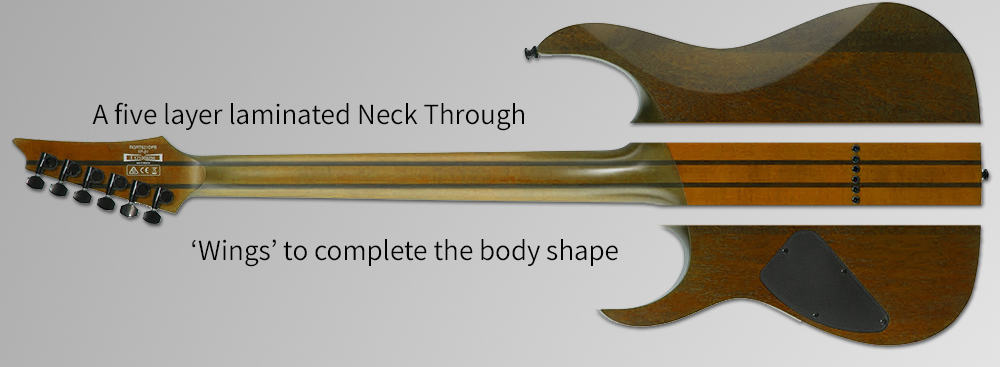
How do you build a Neck Through guitar?
When approaching the construction of such a guitar, you essentially start by building the neck with an extension as long as the body you are planing to have. This will have to be at least as long as your guitar scale length and probably a bit more for the headstock on one side and enough material to comfortably mount your bridge. You also want it to be wide enough to fit the pickups and the bridge which means the heel width is probably not going to be enough. The neck in a ‘Neck Through’ guitar has the bridge, the pickups, the fretboard, the nut, the headstock and the tuners. Other than the two ‘wing’ pieces which will complete and make up the body shape, the rest of the construction would be similar to any other guitar.
Is a ‘Neck Through’ guitar harder to build?
When it comes to mass production, probably yes. A Neck Through guitar will require longer timber and/ or creating a laminated neck. They will also require larger work areas, CNC machines and so on, since you cannot work on smaller parts individually.
For the private builder many of these concerns are not as critical and you may even enjoy the benefits.
- You can easily design a guitar with excellent access to the 24th fret without compromising the strength of the (non-existing) neck joint.
- The neck joint stops being an issue
- Figuring out scale length, pickup positioning, bridge nut and frets is much more intuitive on one piece
- Working out the break angle, especially on Gibson style guitars with a higher Tune-o-Matic bridge is much easier.
Finding the break angle on a through neck guitar?
The neck break angle is the angle a neck has relative to the body of the guitar and it is meant to allow for comfortable action especially on higher type bridges. On most Fender style guitars there is barely if any break angle but all Gibson guitars will have 2-5 degrees at which the neck will be angled. In most cases that angle will be calculated into the either the heel of the neck or the cavity in which it will be mounted into. When building a ‘Neck Through’ guitar you have to incorporate the angle into the one-piece neck. The easiest way to do that, and avoid the math, is to draw the profile of the guitar, in full scale. Start from the strings and work your way down from the nut, the fretboard and the bridge. The strings will ALWAYS be straight so they will give you a great point of reference from which to measure the distance of all the parts. Once the action and the scale length are measured and drawn you will just need to add in the neck and the body in the correct place and ‘voila’ the break angle is already there.
Who makes ‘Neck Through’ guitars?
Rickenbacker were one of the first manufacturers to integrate the feature in production since 1956 in both their 6 strings and bass guitars. The Beatles made sure the Rickenbackers were known and desired.
Ibanez have quit a few models including Kiss’ front man Iceman model (painted so it doesn’t show), a few models from the RGT line and many bass guitars.
Other manufacturers have limited editions or series with ‘Neck Through’ with more bass guitars tending to enjoy it. These also include ESP Guitars, Jackson, Yamaha, Schecter, Strandberg and Carvin.
Even Gibson who are almost synonymous with ‘set-in’ necks have had a few models such as the Firebird and Thunderbird which occasionally had ‘Neck through’
Why Aren’t there more Neck Through Guitars?
Traditional guitar makers are well, traditional. Fenders are proud of their ‘signature’ bolt in necks as are Gibson with the set-in. Both work just fine and they have production optimized around it. Introducing a different method of production is always a pain in the neck. Since the market is also based on demand larger companies will adhere to public demand and create some limited additions or a few models, but it seams the benefits don’t outweigh the cost in their eyes or pockets.
Conclusion or Are ‘Neck Through’ guitars better?
There cannot be a ‘yes’ or ‘no’ answer to this as there are always many opinions and factors to the answer. To best answer I have tried to break the different aspects to which you may have a more definitive answer or preference.
Looks: Looks are in the eye of the beholder. If you like the striped (most models are laminated) look and want it to extend beyond the neck then YES.
Strength: The one piece laminate through neck is probably stronger and sturdier than one with to parts and a joint. Are the traditional joints strong enough? In most cases they are.
Sustain: Even if the ‘Neck Through’ allows for slightly better sustain resonance, most people wouldn’t notice this improvement compared to many other factors. If you do have absolute hearing and feel it really makes a different than sure, go for it. It will probably be easier and cheaper to get a sustain effect pedal for your current guitar.
Design: This is the one place where there is a definite plus to the ‘Neck Through’ guitars. The solid center the neck provides will enable any design around it without fear of weakening the neck joint. With 24 fret guitars becoming more popular the bulky heel and the need to be able to reach those higher frets dictates designs which can be structurally challenging with traditional neck joints.
If you are building your own guitar, the whole process may not seem much harder, or maybe even easier, than traditional built necks. In this case you may not have to overthink it, and enjoy the benefits.

